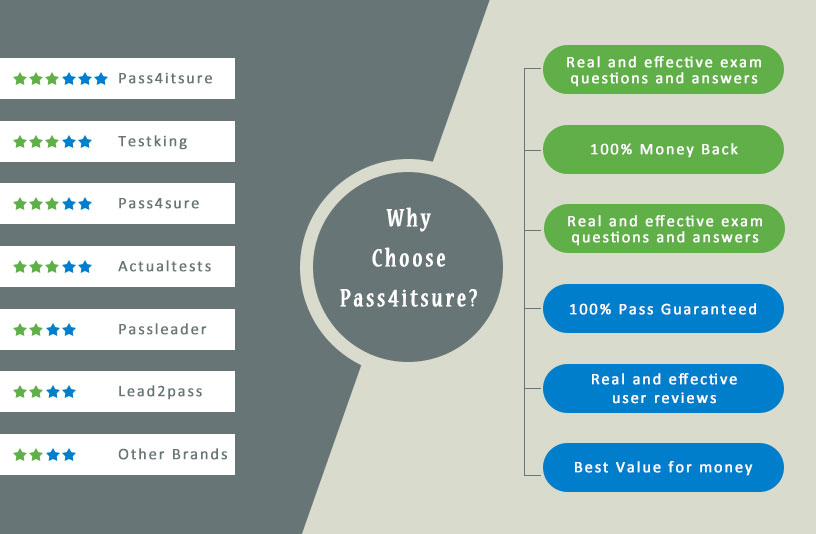Latest Microsoft Azure AZ-100 exam dumps, AZ-100 Exam Practice Tests | 100% Free
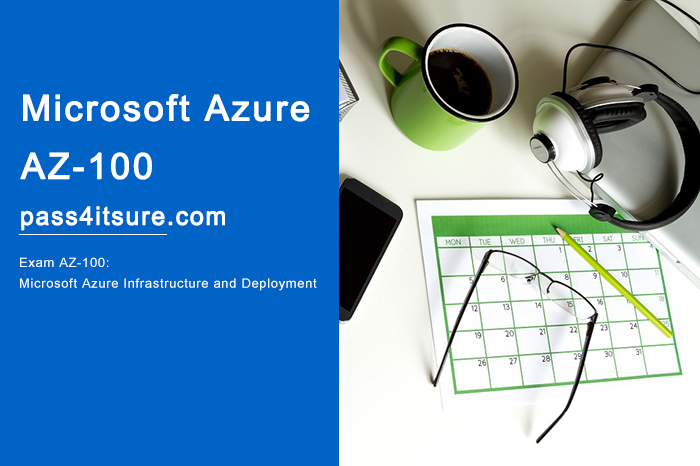
Easily pass the Microsoft Azure AZ-100 exam: “Exam AZ-100: Microsoft Azure Infrastructure and Deployment” – https://www.pass4itsure.com/az-100.html (Q&As: 293) Free share the latest AZ-100 dumps questions and answers! Practice the test online! Improve your skills and exam experience!
Download Microsoft Azure AZ-100 PDF Online
[PDF] Free Microsoft AZ-100 pdf dumps download from Google Drive: https://drive.google.com/open?id=1zH7CVpKF6-fsa3-DymhOuebjST4Zi2pM
[PDF] Free Full Microsoft pdf dumps download from Google Drive: https://drive.google.com/open?id=1gdQrKIsiLyDEsZ24FxsyukNPYmpSUDDO
Valid information provided by Microsoft officials
Exam AZ-100: Microsoft Azure Infrastructure and Deployment: https://www.microsoft.com/en-us/learning/exam-az-100.aspx
Candidates for this exam are Azure Administrators who manage cloud services that span storage, security, networking,
and compute cloud capabilities. Candidates have a deep understanding of each service across the full IT lifecycle and take requests for infrastructure services, applications, and environments. They make recommendations on services to use for optimal performance and scale, as well as provision, size, monitor, and adjust resources as appropriate.
Candidates for this exam should have proficiency in using PowerShell, the Command Line Interface, Azure Portal,
ARM templates, operating systems, virtualization, cloud infrastructure, storage structures, and networking. Related exams: Microsoft Azure AZ-103
pass4itsure AZ-100 Skills measured
- Manage Azure subscriptions and resources (15-20%)
- Implement and manage storage (20-25%)
- Deploy and manage virtual machines (VMs) (20-25%)
- Configure and manage virtual networks (20-25%)
- Manage identities (15-20%)
Latest effective Microsoft Azure AZ-100 Exam Practice Tests
QUESTION 1
You plan to automate the deployment of a virtual machine scale set that uses the Windows Server 2016 Datacenter
image.
You need to ensure that when the scale set virtual machines are provisioned, they have web server components
installed.
Which of the following two actions should you perform? Each correct answer presents part of the solution.
NOTE Each correct selection is worth one point.
A. Create an Azure policy.
B. Upload a configuration script.
C. Create a new virtual machine scale set in the Azure portal.
D. Modify the extension profile section of the Azure Resource Manager template.
Correct Answer: CD
QUESTION 2
You have an Azure Active Directory (Azure AD), tenant.
You have an existing Azure AD conditional access policy named Policy1. Policy1 enforces the use of Azure AD-joined
devices when members of the Global Administrators group authenticate to Azure AD from untrusted locations.
You need to ensure that members of the Global Administrators group will also be forced to use multi-factor
authentication when authenticating from untrusted locations.
What should you do?
A. From the Azure portal, modify session control of Policy1
B. From the multi-factor authentication page, modify the service settings
C. From the multi-factor authentication page, modify the user settings
D. From the Azure portal, modify grant control of Policy1
Correct Answer: D
There are two types of controls:
Grant controls -To gate access
Session controls -To restrict access to a session
Grant controls oversee whether a user can complete authentication and reach the resource that they\\’re attempting to
sign-in to. If you have multiple controls selected, you can configure whether all of them are required when your policy is
processed. The current implementation of Azure Active Directory enables you to set the following grant control
requirements:
References: https://blog.lumen21.com/2017/12/15/conditional-access-in-azure-active-directory/
QUESTION 3
You need to move the blueprint files to Azure. What should you do?
A. Generate a shared access signature (SAS). Map a drive, and then copy the files by using File Explorer.
B. Use the Azure Import/Export service.
C. Generate an access key. Map a drive, and then copy the files by using File Explorer.
D. Use Azure Storage Explorer to copy the files.
Correct Answer: D
Azure Storage Explorer is a free tool from Microsoft that allows you to work with Azure Storage data on Windows,
macOS, and Linux. You can use it to upload and download data from Azure blob storage.
Scenario:
Planned Changes include: move the existing product blueprint files to Azure Blob storage.
Technical Requirements include: Copy the blueprint files to Azure over the Internet.
References: https://docs.microsoft.com/en-us/azure/machine-learning/team-data-science-process/move-data-to-azure-blob-using-azure-storage-explorer
QUESTION 4
You have an Azure subscription that contains the resources in the following table.
Subnet1 is associated with VNet1. NIC1 attaches VM1 to Subnet1.
You need to apply ASG1 to VM1.
What should you do?
A. Modify the properties of NSG1.
B. Modify the properties of ASG1.
C. Associate NIC1 to ASG1.
Correct Answer: B
When you deploy VMs, make them members of the appropriate ASGs. You associate the ASG with a subnet.
References: https://azure.microsoft.com/en-us/blog/applicationsecuritygroups/
QUESTION 5
HOTSPOT
You have an Azure subscription named Subscription1.
You plan to deploy an Ubuntu Server virtual machine named VM1 to Subscription1.
You need to perform a custom deployment of the virtual machine. A specific trusted root certification authority (CA) must
be added during the deployment.
What should you do? To answer, select the appropriate options in the answer area.
NOTE: Each correct selection is worth one point.
Hot Area:
Correct Answer:
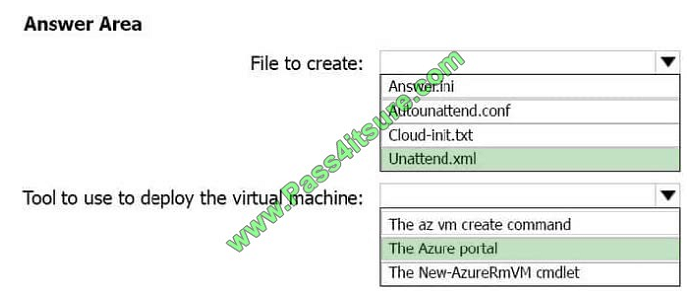
Explanation:
Box 1: Unattend.xml
In preparation to deploy shielded VMs, you may need to create an operating system specialization answer file. On
Windows, this is commonly known as the “unattend.xml” file. The New-ShieldingDataAnswerFile Windows PowerShell
function
helps you do this. Starting with Windows Server version 1709, you can run certain Linux guest OSes in shielded VMs. If
you are using the System Center Virtual Machine Manager Linux agent to specialize those VMs, the New-
ShieldingDataAnswerFile cmdlet can create compatible answer files for it.
Box 2: The Azure Portal
You can use the Azure portal to deploy a Linux virtual machine (VM) in Azure that runs Ubuntu.
References: https://docs.microsoft.com/en-us/azure/virtual-machines/linux/quick-create-portal
QUESTION 6
DRAG DROP
You have two Azure virtual machines named VM1 and VM2. VM1 has a single data disk named Disk1. You need to
attach Disk1 to VM2. The solution must minimize downtime for both virtual machines.
Which four actions should you perform in sequence? To answer, move the appropriate actions from the list of actions to
the answer area and arrange them in the correct order.
Select and Place:
Correct Answer:
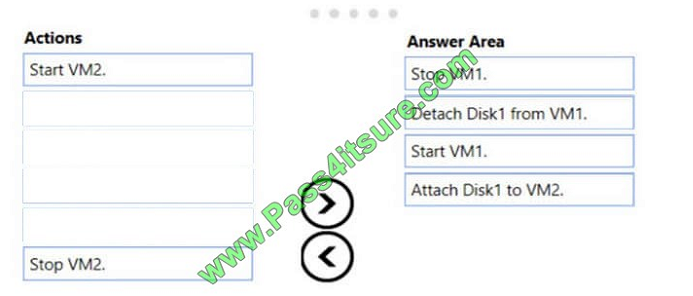
Explanation:
Step 1: Stop VM1.
Step 2: Detach Disk1 from VM1.
Step 3: Start VM1.
Detach a data disk using the portal
1. In the left menu, select Virtual Machines.
2. Select the virtual machine that has the data disk you want to detach and click Stop to deallocate the VM.
3. In the virtual machine pane, select Disks.
4. At the top of the Disks pane, select Edit.
5. In the Disks pane, to the far right of the data disk that you would like to detach, click the Detach button image detach
button.
6. After the disk has been removed, click Save on the top of the pane.
7. In the virtual machine pane, click Overview and then click the Start button at the top of the pane to restart the VM.
8. The disk stays in storage but is no longer attached to a virtual machine.
Step 4: Attach Disk1 to VM2 Attach an existing disk Follow these steps to reattach an existing available data disk to a
running VM.
1. Select a running VM for which you want to reattach a data disk.
2. From the menu on the left, select Disks.
3. Select Attach existing to attach an available data disk to the VM.
4. From the Attach existing disk pane, select OK.
References: https://docs.microsoft.com/en-us/azure/virtual-machines/windows/detach-disk
https://docs.microsoft.com/en-us/azure/lab-services/devtest-lab-attach-detach-data-disk
QUESTION 7
Note: This question is part of a series of questions that present the same scenario. Each question in the series contains
a unique solution that might meet the stated goals. Some question sets might have more than one correct solution,
while
others might not have a correct solution.
After you answer a question in this section, you will NOT be able to return to it. As a result, these questions will not
appear in the review screen.
You have a computer named Computer1 that has a point-to-site VPN connection to an Azure virtual network named
VNet1. The point-to-site connection uses a self-signed certificate.
From Azure, you download and install the VPN client configuration package on a computer named Computer2.
You need to ensure that you can establish a point-to-site VPN connection to VNet1 from Computer2.
Solution: You modify the Azure Active Directory (Azure AD) authentication policies.
Does this meet this goal?
A. Yes
B. No
Correct Answer: B
QUESTION 8
You have an on-premises network that contains a Hyper-V host named Host1. Host1 runs Windows Server 2016 and
hosts 10 virtual machines that run Windows Server 2016.
You plan to replicate the virtual machines to Azure by using Azure Site Recovery.
You create a Recovery Services vault named ASR1 and Hyper-V site named Site1.
You need to add Host1 to ASR1.
What should you do?
A. Download the installation file for the Azure Site Recovery Provider. Download the vault registration key. Install the
Azure Site Recovery Provider on Host1 and register the server.
B. Download the installation file for the Azure Site Recovery Provider. Download the storage account key. Install the
Azure Site Recovery Provider on each virtual machine and register the virtual machines.
C. Download the installation file for the Azure Site Recovery Provider. Download the vault registration key. Install the
Azure Site Recovery Provider on each virtual machine and register the virtual machines.
D. Download the installation file for the Azure Site Recovery Provider. Download the storage account key. Install the
Azure Site Recovery Provider on Host1 and register the server.
Correct Answer: A
Download the Vault registration key. You need this when you install the Provider. The key is valid for five days after you
generate it.
Install the Provider on each VMM server. You don\\’t need to explicitly install anything on Hyper-V hosts.
Incorrect Answers:
B, D: Use the Vault Registration Key, not the storage account key.
References:
https://docs.microsoft.com/en-us/azure/site-recovery/migrate-tutorial-on-premises-azure
QUESTION 9
Note: This question is part of a series of questions that present the same scenario. Each question in the series contains
a unique solution that might meet the stated goals. Some question sets might have more than one correct solution,
while
others might not have a correct solution.
After you answer a question in this section, you will NOT be able to return to it. As a result, these questions will not
appear in the review screen.
You manage a virtual network named VNet1 that is hosted in the West US Azure region.
VNet1 hosts two virtual machines named VM1 and VM2 that run Windows Server.
You need to inspect all the network traffic from VM1 to VM2 for a period of three hours.
Solution: From Performance Monitor, you create a Data Collector Set (DCS).
Does this meet the goal?
A. Yes
B. No
Correct Answer: B
You should use Azure Network Watcher.
References: https://docs.microsoft.com/en-us/azure/network-watcher/network-watcher-monitoring-overview
QUESTION 10
You have two Azure virtual machines named VM1 and VM2. You have two Recovery Services vaults named RSV1 and
RSV2.
VM2 is protected by RSV1.
You need to use RSV2 to protect VM2.
What should you do first?
A. From the RSV1 blade, click Backup items and stop the VM2 backup.
B. From the RSV1 blade, click Backup Jobs and export the VM2 job.
C. From the RSV2 blade, click Backup. From the Backup blade, select the backup for the virtual machine, and then click
Backup.
D. From the VM2 blade, click Disaster recovery, click Replication settings, and then select RSV2 as the Recovery
Services vault.
Correct Answer: D
References: https://docs.microsoft.com/en-us/azure/backup/backup-azure-vms-first-look-arm
QUESTION 11
DRAG DROP
You have an Azure Active Directory (Azure AD) tenant that has the initial domain name.
You have a domain name of contoso.com registered at a third-party registrar.
You need to ensure that you can create Azure AD users that have names containing a suffix of @contoso.com.
Which three actions should you perform in sequence? To answer, move the appropriate cmdlets from the list of cmdlets
to the answer area and arrange them in the correct order.
Select and Place:
Correct Answer:
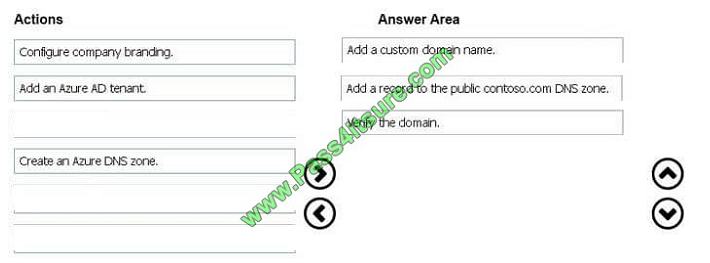
Explanation:
The process is simple:
1. Add the custom domain name to your directory
2. Add a DNS entry for the domain name at the domain name registrar
3. Verify the custom domain name in Azure AD References: https://docs.microsoft.com/en-us/azure/dns/dns-web-sites-custom-domain
QUESTION 12
Note: This question is part of a series of questions that present the same scenario. Each question in the series contains
a unique solution that might meet the stated goals. Some question sets might have more than one correct solution,
while
others might not have a correct solution.
After you answer a question in this section, you will NOT be able to return to it. As a result, these questions will not
appear in the review screen.
You have an Azure subscription named Subscription1. Subscription1 contains a resource group named RG1. RG1
contains resources that were deployed by using templates.
You need to view the date and time when the resources were created in RG1.
Solution: From the Subscriptions blade, you select the subscription, and then click Programmatic deployment.
Does this meet the goal?
A. Yes
B. No
Correct Answer: B
QUESTION 13
SIMULATION
Overview
The following section of the exam is a lab. In this section, you will perform a set of tasks in a live environment. While
most functionality will be available to you as it would be in a live environment, some functionality (e.g., copy and paste,
ability
to navigate to external websites) will not be possible by design.
Scoring is based on the outcome of performing the tasks stated in the lab. In other words, it doesn\\’t matter how you
accomplish the task, if you successfully perform it, you will earn credit for that task.
Labs are not timed separately, and this exam may have more than one lab that you must complete. You can use as
much time as you would like to complete each lab. But, you should manage your time appropriately to ensure that you
are
able to complete the lab(s) and all other sections of the exam in the time provided.
Please note that once you submit your work by clicking the Next button within a lab, you will NOT be able to return to
the lab.
To start the lab
You may start the lab by clicking the Next button.
You plan to prevent users from accidentally deleting blob data from Azure.
You need to ensure that administrators can recover any blob data that is deleted accidentally from the
storagelod8095859 storage account for 14 days after the deletion occurred.
What should you do from the Azure portal?
Correct Answer: See below.
Task A: Create a Recovery Services vault (if a vault already exists skip this task, go to Task B below)
A1. From Azure Portal, On the Hub menu, click All services and in the list of resources, type Recovery Services and
click Recovery Services vaults.
If there are recovery services vaults in the subscription, the vaults are listed. A2. On the Recovery Services vaults
menu, click Add.
Task B. Create a backup goal
B1. On the Recovery Services vault blade (for the vault you just created), in the Getting Started section, click Backup,
then on the Getting Started with Backup blade, select Backup goal.
A3. The Recovery Services vault blade opens, prompting you to provide a Name, Subscription, Resource group, and
Location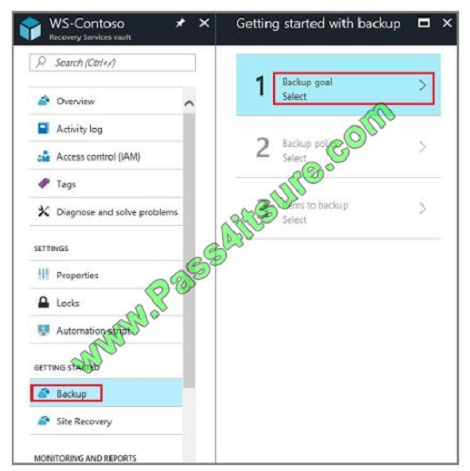
The Backup Goal blade opens. If the Recovery Services vault has been previously configured, then the Backup Goal
blades open when you click Backup on the Recovery Services vault blade. B2. From the Where is your workload
running? drop-down menu, select Azure.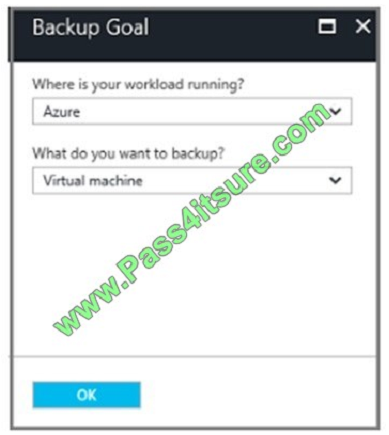
B3. From the What do you want to backup? menu, select Blob Storage and click OK.
B4. Finish the Wizard.
Task C. create a backup schedule
C1. Open the Microsoft Azure Backup agent. You can find it by searching your machine for Microsoft Azure Backup.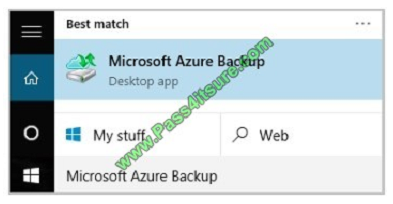
C2. In the Backup agent\\’s Actions pane, click Schedule Backup to launch the Schedule Backup Wizard.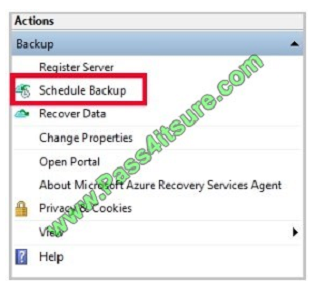
C3. On the Getting started page of the Schedule Backup Wizard, click Next.
C4. On the Select Items to Backup page, click Add Items.
The Select Items dialog opens.
C5. Select Blob Storage you want to protect, and then click OK.
C6.In the Select Items to Backup page, click Next.
On the Specify Backup Schedule page, specify Schedule a backup every day, and click Next.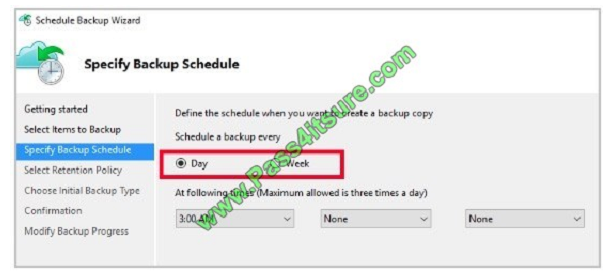
C7. On the Select Retention Policy page, set it to 14 days, and click Next.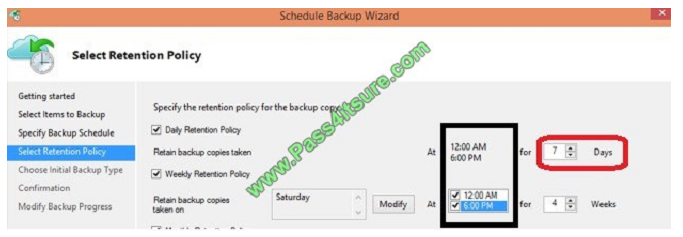
C8. Finish the Wizard.
References: https://docs.microsoft.com/en-us/azure/backup/backup-configure-vault
The latest Microsoft Azure AZ-100 dumps help you get on the ladder of success! Get the latest updates from AZ-100 exam: https://www.pass4itsure.com/az-100.html (Q&As: 293) For more effective exam dumps, follow me!
Pass4itsure Promo Code 15% Off

Why Choose Pass4itsure?
Pass4itsure is the best provider of IT learning materials and the right choice for you to prepare for the Microsoft AZ-100 exam.
Other brands started earlier, but the price is relatively expensive and the questions are not the newest. Pass4itsure provides the latest real questions and answers with the lowest prices, help you pass AZ-100 exam easily at first try.
